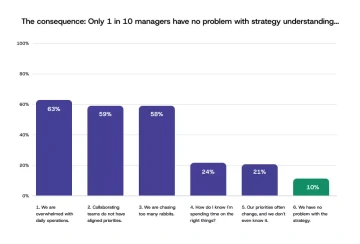Three signs that your people don't understand your strategy
22. 1. 2025

What you will find in this article: We will explore three signs that indicate a lack of strategic clarity and alignment within your company, such as low scores in employee satisfaction surveys and symptoms of daily operational overwhelm. The article also provides actionable steps and tools to assess and enhance strategic articulation and alignment across your organization, helping leaders ensure everyone is on the same page.
Are you also a victim of so-called C-level blindness?
Do your people really understand your strategy? How can you tell? Many top executives experience what we call "C-level blindness." They're deeply involved in setting the company's strategy, more so than anyone else. Because of this deep involvement, they often believe that the strategy they created is as clear to everyone else in the company as it is to them (not mentioning the fact that even on top-management level, the understanding can differ from person to person).
Still today, I am always truly surprised to see the genuine surprise of C-level executives when they realize it is far from the truth.
The question is: how can you overcome „C-level blindness“? How can you determine if your company needs significant improvement in defining, articulating, and aligning its strategy?
1. Read carefully your Employee satisfaction surveys
A typical first sign is receiving less favorable scores in your employee satisfaction survey (or Pulse, or Health Check, whichever tool you use). In fact, about 50% of our collaborations on strategic articulation, communication, and alignment are triggered by this very issue.
2. Become sensitive to symptoms of strategic unclarity
Based on our research, three common symptoms indicate that your strategy may not be clear enough to your team:
"We are overwhelmed by our regular daily tasks": 63% of all senior to first-line managers report being overloaded with routine daily tasks, often without understanding their importance.
"We are not aligned with the teams we need to collaborate with": Six out of ten participants state that mismatched or conflicting priorities among collaborative teams disrupt their added value.
"We are chasing too many rabbits": 58% of people leaders indicate that their sense of overload stems from having too many priorities that need attention, for various reasons.
3. Assess strategic clarity and alignment in your organization
How can you do it? Offer your people three simple statements to evaluate during a live poll (e.g. during your all-staff meetings) .
Our company strategy is clearly and simply articulated.
We have perfect vertical alignment of our strategic priorities (across all organizational layers).
We have perfect horizontal alignment of our strategic priorities (among collaborating teams).
Team members can vote on how much they agree with these statements on a scale from 1 (strong disagreement) to 10 (full agreement).
If you score below 8.5 in any of these areas, it's a clear sign that improvement is needed.
HOW ALAIGNED CAN HELP YOU
For articulation of your strategic essentials, use a simple format of our Strategy One-Pager. Populate it together with critical members of your team. This will secure their buy-in (co-creation naturally leads to a sense of ownership). But the greatest advantage is that your leaders see the strategy the same way, eventually. Your leadership team will become fully aligned after this exercise.
Alaigned platform is designed to facilitate the cascade down and provides great support in horizontal alignment among teams.



